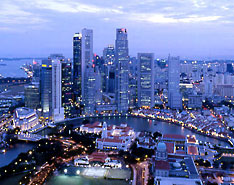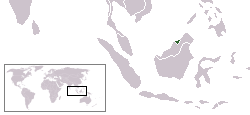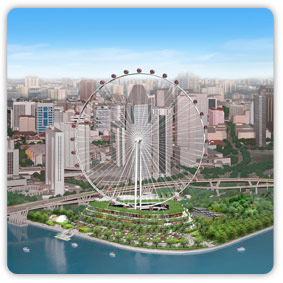Dr M Soldiers On
 Former Malaysian Prime Minister Dr Mahathir Mohamad (pix illustration from kickdefella) is still in his combative mood and has not lost his wit despite his recent heart attack.
Former Malaysian Prime Minister Dr Mahathir Mohamad (pix illustration from kickdefella) is still in his combative mood and has not lost his wit despite his recent heart attack.
According to The Nation newspaper in Thailand this week, he threw his support behind Thailand's diplomatic spat with Singapore, accusing the city-state of interfering in the Thailand's internal affairs and violating diplomatic norms by permitting a senior government official to meet ousted premier Thaksin Shinawatra.
Some observers may feel that the retired Malaysian leader should just shut up like a pensioner. And he should not add fuel to fire in the squabble between neighbours. There is some truth in it.
But there is also the view that Dr Mahathir is a strong Asian voice, often saying things bluntly without fear or favour. After all, who else would say that US President George Bush should be tried for the invasion of Iraq? Please see Dr Mahathir's current mission and earlier postings.
Of course, Dr Mahathir is well positioned to talk about his relationship with Singapore, as mentioned in an earlier posting.
The following is the full transcript of his interview with The Nation's Group Editor Thepchai Yong in Langkawi over the weekend.
Q : How do you see the on-going spat between Thailand and Singapore?
A : Well I hate to say but I think it was unwise for Singapore to seek advantages from Thailand's problems. Because they saw that Thaksin was in need of some help and they extended help not in the way that could be appreciated by the Thai people. And in the present situation, Thaksin's visit to Singapore obviously to discuss this thing, was not very diplomatic.
Q : So Thaksin shouldn't have been welcomed by Singapore's deputy prime minister.
A : Yeah, that was not necessary. There are other places you can meet to discuss business. Because I'm quite sure in order to talk business, that's why they met.
Q : Talking business could be one thing, but knowing that such reception would draw reaction from Thailand. The Thai Foreign Ministry made it clear that they had warned the Singaporean government that there would be reaction if Thaksin met its deputy prime minister. And yet the Singaporeans went ahead with it?
A : Well you see, Singapore does not really care about the opinions of its neighbours, Singapore has been very unfeeling, not sympathetic to the problems of their neighbours. And we have problems with Singapore. In my 22 years in office I tried to resolve them by being friendly but I couldn't solve these problems with Singapore.
Q : Why would Singapore not want to be friendly with Malaysia ?
A : Singapore wants to win and they believe that the most important thing is what profits Singapore. What others get is not relevant.
Q :Profits in what term, business term or diplomatic term?
A : In business term, in diplomatic term, in whatever way, Singapore must be top.
Q : The Thai Foreign Ministry reacted by suspending a visit by the Singaporean foreign minister. Do you think that was the right reaction?
A : Well you know me, I'm very tough in certain things. If I find a foreign minister in another country say nasty thing about my country that is not in the interest of my country, I would have acted very strongly.
Q : Would you have done the same?
A : Probably I would do the same.
Q : Do you think Thailand and Singapore should try to patch things up?
A : Yeah, I think they should, but in a way that is honorable.
Q : Who should take the initiative? The Thais believe that Singapore owes them an apology.
A : I think Singapore should apologize because basically Singapore was interfering in the internal affairs of Thailand, and that was not good. You see, Thaksin has problems with Thailand and its people, not with Singapore. But Singapore comes in, in order to help Thaksin. And I think it didn't work.
Q : In Thailand they say if you want to know how to deal with Singapore, talk to the Malaysians. What can we learn from your experience in dealing with Singapore?
A : Either being nice or being tough, they always think about themselves. And they think you won't be able to touch them. They are beyond any action that you may be able to take. That's the character of Singapore, not one cent for anybody else, unless they gain something.
Q : So you're suggesting that Thailand should continue to be tough with Singapore.
A : You should try to get what is your right from Singapore, but it's going to be difficult. Singapore is likely to ask you for some concessions, here there and everywhere Otherwise you won't get back what is yours by right, but that is the way Singapore deals with people.
Q : Did it surprise you that Thai army chief Gen Sonthi and the coup leader few weeks ago said every phone call in Thailand has been monitored by Singapore?
A : I wouldn't be surprised because that's the kind of things they do.
Q : You mean they eavesdrop on friends?
A : Yes they do, they even spy on friends.
Q :That happens to Malaysia too?
A : Yes, one of my political secretaries was removed and detained because he was known to be associated with somebody from Singapore. Of course, Singapore denied, but our police believe that he was passing information.
Q : But why wire-tapping friends? Neighbours shouldn't do this to each other.
A : Well, but we find friends do tap and listen to what friends talk about, but I think Singapore does it in a much more offensive kind of way.
Q : So Thailand and Singapore should sit down and find ways to get their relations back to normal. But can they be normal again?
A : It will be difficult but I think I believe in trying.
Q : Should Thais make the initiative or should Singapore do it first? Thais have been very angry and feel very strongly about this.
A : I think we need a cooling down period.
























 (Pix source:
(Pix source: 




 March 27: Temasek hogs headlines
March 27: Temasek hogs headlines April 18: TT Durai charged with graft at NKF
April 18: TT Durai charged with graft at NKF May 6: PAP returned to power
May 6: PAP returned to power
 May 26 and Dec 8: Singapore hands out casino licences
May 26 and Dec 8: Singapore hands out casino licences July 21: Lee Hsien Yang announces decision to step down
July 21: Lee Hsien Yang announces decision to step down Aug 23: Creative versus Apple
Aug 23: Creative versus Apple Dec 13: Irrational exuberance reigns at Marina Bay Residences
Dec 13: Irrational exuberance reigns at Marina Bay Residences Sept 10-20: IMF and World Bank meetings bring in 16,000 visitors
Sept 10-20: IMF and World Bank meetings bring in 16,000 visitors
 BY TUN DR. MAHATHIR MOHAMAD
BY TUN DR. MAHATHIR MOHAMAD



